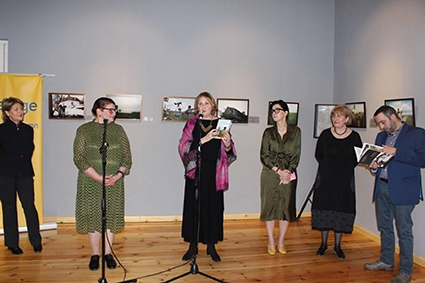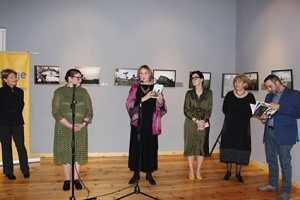Interpreter & Swedish Film Critic Brings Photo Chronicle of Tarkovsky’s Last Film to Tbilisi
On March 14, a multicultural and exciting event took place in Tbilisi: the opening of an exhibition presenting a photo chronicle of Andrey Tarkovsky’s last film ‘Sacrifice’ at the Art Palace. The project was organized through the mutual effort of the British Georgian Chamber of Commerce (BGCC), Embassy of Sweden in Tbilisi, State Museum of Music, Theater, Cinema and Choreography (Art Palace) and the Georgian Film Academy. The exhibition was presented by guest of honor from London, Swedish film critic, writer and author of the photos, Layla Alexander Garrett. Within the frames of the project, a movie about Tarkovsky by Polish director Michal Leszczylowsk was premiered at the Georgian Film Academy.
Andrei Tarkovsky is widely regarded as one of cinema’s true masters and although he only made seven features, each was more affecting and mature than the one before it. The Russian director, who was oppressed by the Soviet regime, visited Georgia and had very close friendly relations with Sergei Parajanov, a famous film director of Armenian descent based in Tbilisi.
‘Sacrifice’ was filmed in Sweden, on the island of Gotland, in 1985, while Tarkovsky was in exile. It turned out to be his last. As a result, although the director did not know that he was dying, the film appears as a final testament that urges everyone to take personal responsibility for everything that happens in the world.
Gotland is the largest island in Sweden, very close to Russia, and Tarkovsky would stand on the shore and look at Russia, knowing he could not go back (it was still the Soviet Union at the time). Many renowned Swedish actors starred in the hugely successful film, and renowned Swedish filmmaker Ingmar Bergman once said: “Andrei Tarkovsky is for me the greatest, a man who invented a new language; true to the nature of film as mirror of life, life as a dream.”
Layla Alexander Garrett was on set during the shooting of the film, took many pictures and kept a diary during this period. She also served as Tarkovsky’s on-set interpreter. Her diary became the basis for her book about Tarkovsky. Before opening the Art Palace exhibition, Garrett presented her book about Tarkovsky called ‘The Collector of Dreams,’ which can be bought on Amazon. She then thanked Mako Abashidze, Founding Director of the British Georgian Chamber of Commerce (BGCC), for helping her make a ‘Tarkovsky Festival’ in London in 2007 and then assisting in creating the ‘Parajanov Festival’ in 2010.
As Garrett recalled, Tarkovsky used to say that, for him, art was a like prayer and an expression of a hope and “all the rest has nothing to do with art;” that when the last prayer and poet disappears, it will be “the end of humanity.”
“Tarkovsky loved Georgia very much and said that he felt spiritually at ease there,” Garrett told us. “He visited Tbilisi in 1982 and stayed for two weeks. He came to see Sergei Parajanov, whom he appreciated and loved very much, and many other people in Georgia. In his diary, he recalled Parajanov as not only a genius of his profession but generally ‘of everything,’ possessing a unique personality. It was a rare thing, since Tarkovsky rarely recognized or praised his colleagues and other directors of his time.”
“Georgia was the place to which he was closely related. His father, well-known Soviet poet Arseny Tarkovsky, came to Georgia in 1945,” Garrett elaborated. “We discovered his muse was Ketevan Ananiashvili, who was a teacher. Arseny Tarkovsky dedicated many poems to Georgia and to this particular woman. This is a very important exhibition and I’m delighted to see so many people attending it. Tarkovsky is a director who talked about personal responsibility and spiritual development and this exhibition presents some episodes of the making of his last film,” she said, noting that her dream is to show the full retrospective of the seven films of Tarkovsky on the big screen in Tbilisi.
“The film’s budget was only two million and we had to overcome many unpredicted obstacles when filming,” Garrett noted. “Sweden’s contribution to the film was immense. We had to reshoot the fire scene and build a new house when the camera jammed and all the wires connecting to the house burnt, so it was a fiasco. We were shooting in summer, and though nobody worked during this period on the island, the local Swedes helped the film to get back on track. Even the head of the local wood factory came back from his holiday and opened his factory and gave us the wood needed to rebuild the house. We had Bergman’s old team working on the film. These people committed themselves and gave everything for Tarkovsky. Sven Nykvist and Erland Josephson contributed their own money so the film could be completed, without telling Tarkovsky. When he found out, he was so moved by the Swedish generosity and love that he got tears in his eyes. When Tarkovsky was dying from lung cancer, the Swedish team worked literally 24/7 to finish the film for the Cannes Film Festival, where it won the Special Jury Prize. When the film was screened at the Cannes festival in May, soon after the Chernobyl disaster that happened April that year, all the critics said that Tarkovsky had prophesized the nuclear war.”
Mako Abashidze told GEORGIA TODAY more about the exhibition.
“This project was initiated by the British Georgian Chamber of Commerce. Apart from trade, the aim of the organization is to foster a closer relationship between the two countries. We already organized the same exhibition in the UK and since Tarkovsky had many connections with Georgia, we decided to bring the exposition to Tbilisi as well. I want to express my sincere gratitude to Giorgi Kalandia [Art Palace Director] and the Art Palace museum for having significantly contributed to this project end enabling the exhibition to happen. I also want to thank the Embassy of Sweden who supported and was co-organizer. We, together with Ms Layla, also organized a mutual project in London named the Parajanov Festival within the frames of which Parajanov’s films were shown alongside his collages. Now, we are pleased to present this joint project in Tbilisi,” she said.
The Ambassador of Sweden to Georgia, Ulrik Tideström, thanked the director of the museum for hosting the exhibition as well as the initiators and curator of the project for bringing the display to Georgia.
“This is a multicultural project that has the potential to bring people together. This exhibition was shown one year ago with huge success at the Ingmar Bergman Festival, so it is an honor and privilege for all of us to now have the exhibition in Tbilisi,” the Ambassador noted.
The exhibition closes on March 23 at 6 PM
Art Palace, 6 Kargareteli St., Tbilisi
By Lika Chigladze
Image source: Art Palace











